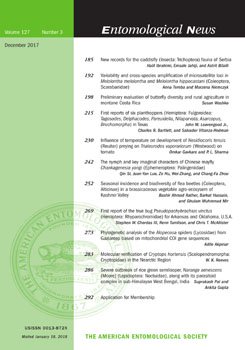The relationship between insect development rate and temperature represents an important ecological variable for modeling the population dynamics of insects. The development time of different stages of Nesidiocoris tenuis (Reuiter) (Hemiptera: Miridae) was determined at 15, 20, 25, 30, and 35°C by using Trialeurodes vaporariorum (Westwood) as prey on tomato (Solanum esculentum (Miller). N. tenuis was able to complete development with a similar (five) number of nymphal instars at temperatures between 15 and 35°C. Development rate of the insect was temperature-dependent and temperatures above 25°C were suitable for faster development. The developmental threshold varied from 6.66°C for third instar nymphs to 12.12°C for the first instar nymphs. The thermal constant also varied with developmental stage and was lowest (26.25 degree-days) for the first instar nymphs, and highest (200 degree-days) for the egg stage. The degree-day requirements were 250 for the entire nymphal stage and 500 for the egg to adult stage. The information generated can be used for developing phenological models based on temperature and development rate relationships, and for programming mass breeding for commercial purposes.
How to translate text using browser tools
1 December 2017
Influence of Temperature on Development of Nesidiocoris tenuis (Reuiter) Preying on Trialeurodes vaporariorum (WESTWOOD) on Tomato
Omkar Gavkare,
P. L. Sharma
ACCESS THE FULL ARTICLE

Entomological News
Vol. 127 • No. 3
December 2017
Vol. 127 • No. 3
December 2017
degree-days
developmental threshold
greenhouse whitefly
Miridae
thermal constant




